Werribee Welcome Swallows come in several colour schemes at the moment. Along with the usual adult and juvenile plumage there is at least one white swallow flying with the flock. I first saw it a couple of weeks ago and it was a magical sight, unfortunately the other swallows don’t find it so attractive.
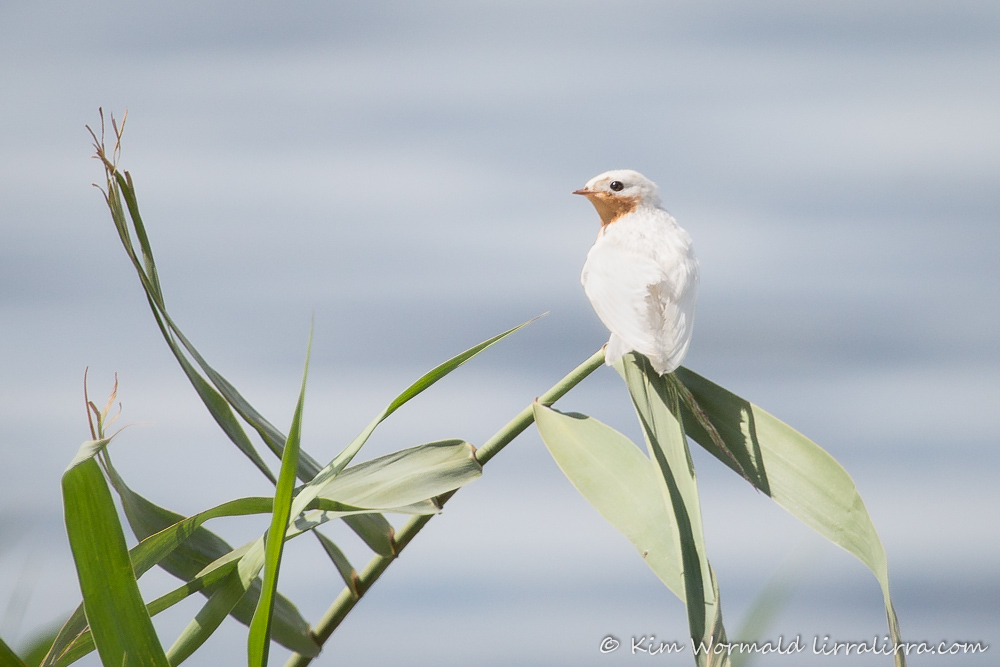 Welcome Swallow – leucistic
Welcome Swallow – leucistic
5DIII, 100-400mm L IS USM, 1/2000, f/5.6, +1 EV, ISO 400, focal length 400mm
This poor bird gets little chance to rest as other swallows repeatedly swoop towards it until it takes flight and is chased away. The flying swallow in the image below was one of a group that were dive-bombing the bird. Life won’t be easy for the white bird, not only is it hassled by its own species but its lack of pigmentation makes it a more obvious target for predators. Another problem is that melanin not only gives feathers their colouration but also helps give them strength which means this swallow’s feathers will be weak, wearing out more quickly and making flying more arduous.
The white Welcome Swallow paused briefly on reeds at the edge of a pond, I swung around and fired a couple of quick shots with the camera at a ridiculous angle before the bird flew. The original image has the bird and water ripples leaning at 45 degrees. I don’t usually crop so heavily, and have never needed to straighten so drastically.
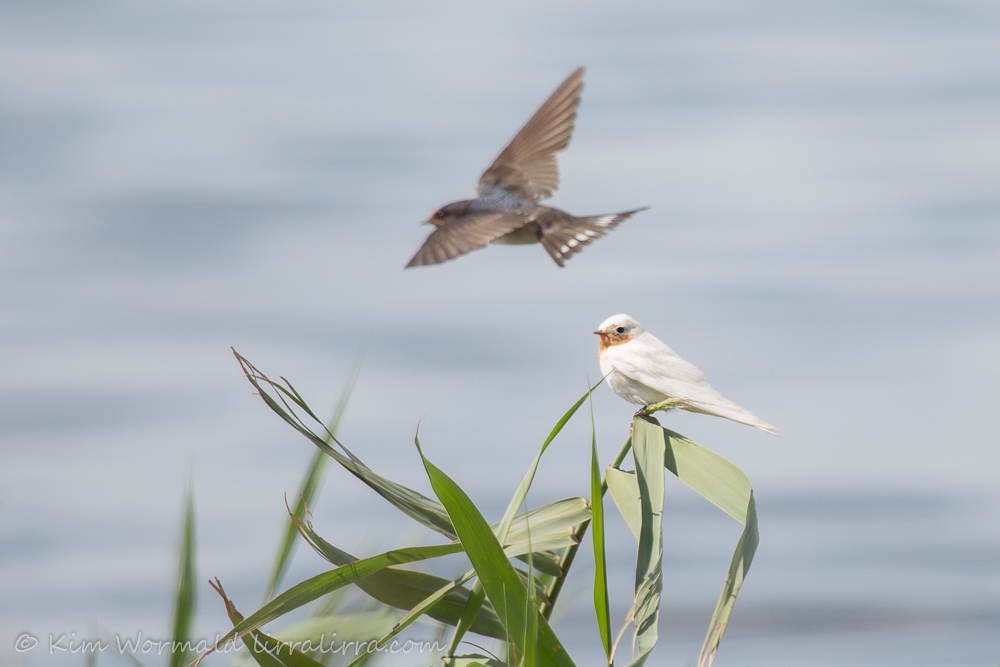 Welcome Swallow – leucistic
Welcome Swallow – leucistic
5DIII, 100-400mm L IS USM, 1/2000, f/5.6, +1 EV, ISO 400, focal length 400mm
Leucism can result in a variety of plumage abnormalities including dark birds with white patches, ‘diluted’ birds and white birds that can retain some colouring in their eyes, bills and legs while also retaining any yellow colouring which would usually be present – according to this definition the white Welcome Swallow fits the criteria for leucism. Leucistic birds lack melanin pigment because the cells that produce melanin are absent.
Several years ago I wrote a few words for the magazine of the Bird Observers’ Club of Australia (BOCA, now amalgamated with Birds Australia to form Birdlife Australia) about an albinistic Superb Fairy-wren. The wren’s feathers were pure white but it had colouring in its eyes, legs and bill. Albinistic was considered the appropriate word at the time whereas now it seems the terminology has evolved and ‘albinistic’ is rarely used. Albinism relates to a genetic inability to produce melanin pigments due to the absence of a critical enzyme, the condition produces birds with white feathers, pink eyes and no colouring in their bills or legs. This Welcome Swallow is not an albino as, although it seems to have no colouring in its legs or bill, it has dark eyes and has retained rufous colouring on its throat and chest.
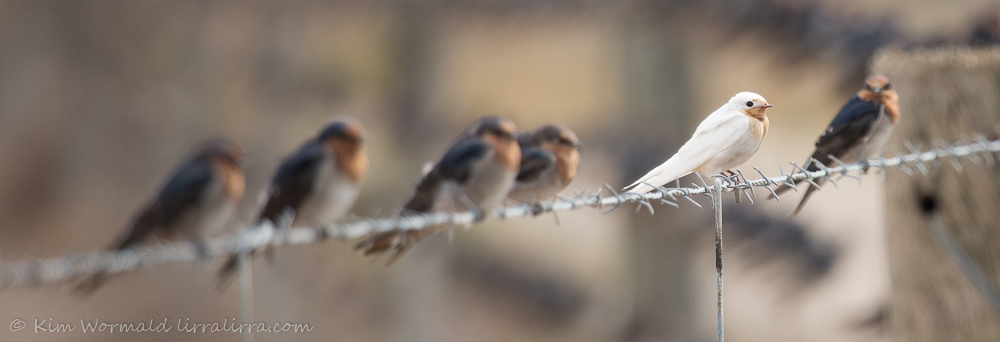 Welcome Swallow – leucistic
Welcome Swallow – leucistic
5DIII, 100-400mm L IS USM, 1/1250, f/5.6, +2/3 EV, ISO 400, focal length 400mm
From the amount of rufous colouring on the swallow’s throat, chest and forehead I believe the leucistic bird is likely to be a juvenile. Did you notice the other rows of swallows in the background of the image above?
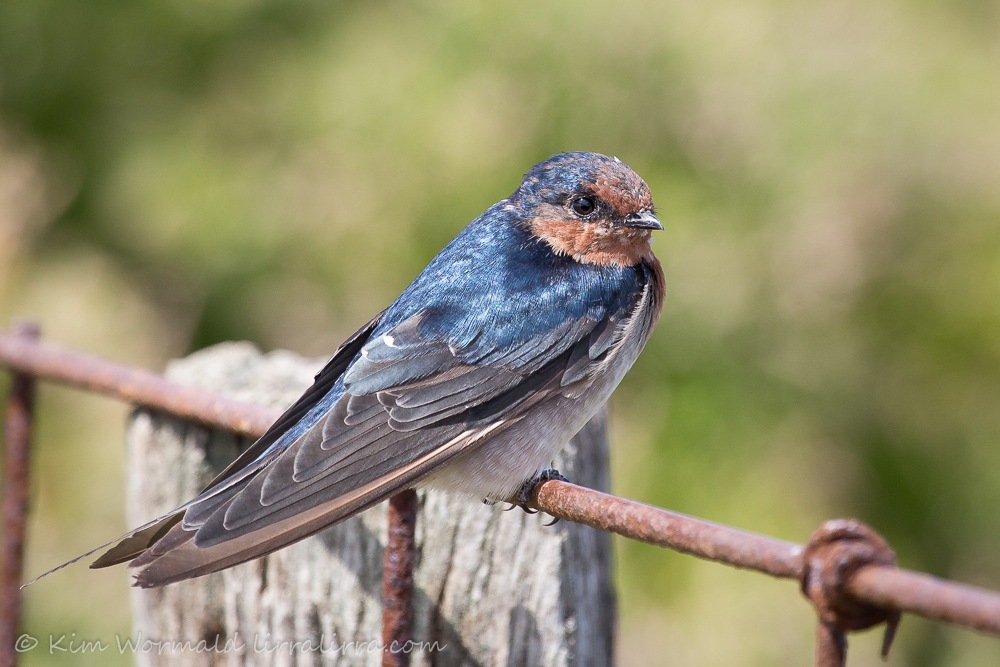
Welcome Swallow
5DIII, 100-400mm L IS USM, 1/800, f/6.3, ISO 400, focal length 400mm
The colouring of this adult Welcome Swallow looks amazingly vivid after looking at the leucistic bird but I have not tweaked it during post production. I prefer staying true to a bird’s natural colours, they are beautiful enough without adding saturation.
 Welcome Swallow
Welcome Swallow
5DIII, 100-400mm L IS USM, 1/1000, f/5.6, ISO 400, focal length 400mm
I particularly like the subtle colouring of young Welcome Swallows and the image above and following images show individual birds with small differences as they gradually develop their adult plumage. The bird above has developed two tiny patches of dark rufous colouring on its head and neck along with a narrow band of darker feathers above its bill.
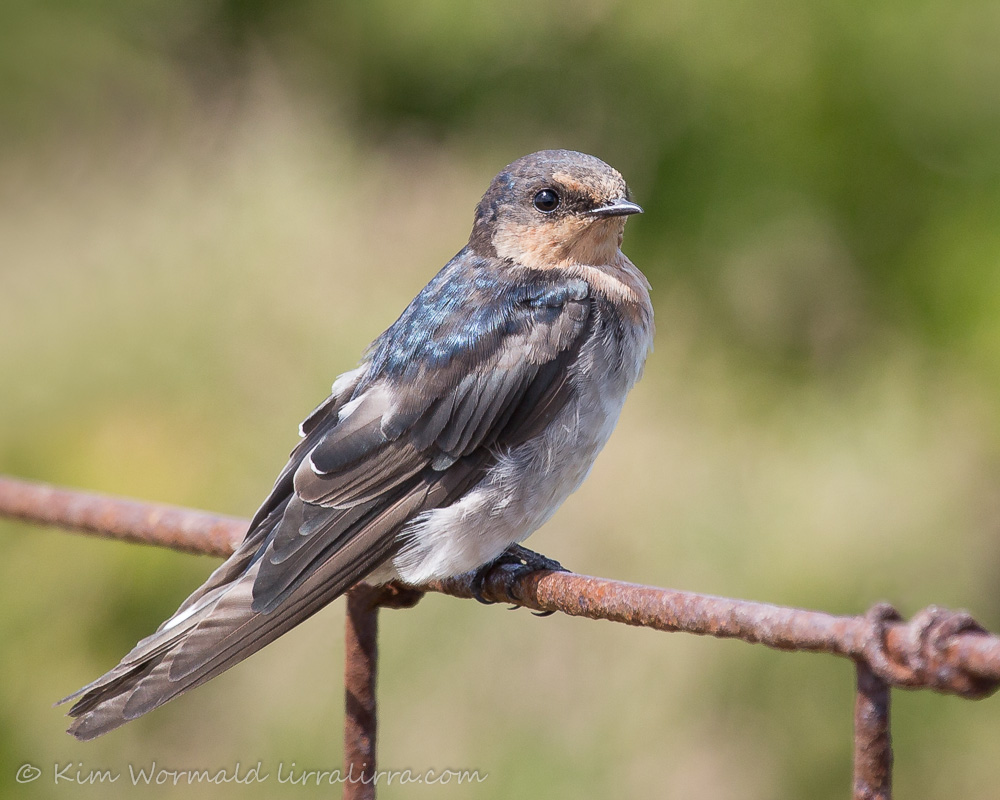 Welcome Swallow
Welcome Swallow
5DIII, 100-400mm L IS USM, 1/800, f/6.3, ISO, focal length 400mm
The juvenile above is developing its rufous feathers and blue-black back; I like the way this rusty wire fence complements the bird and the background.
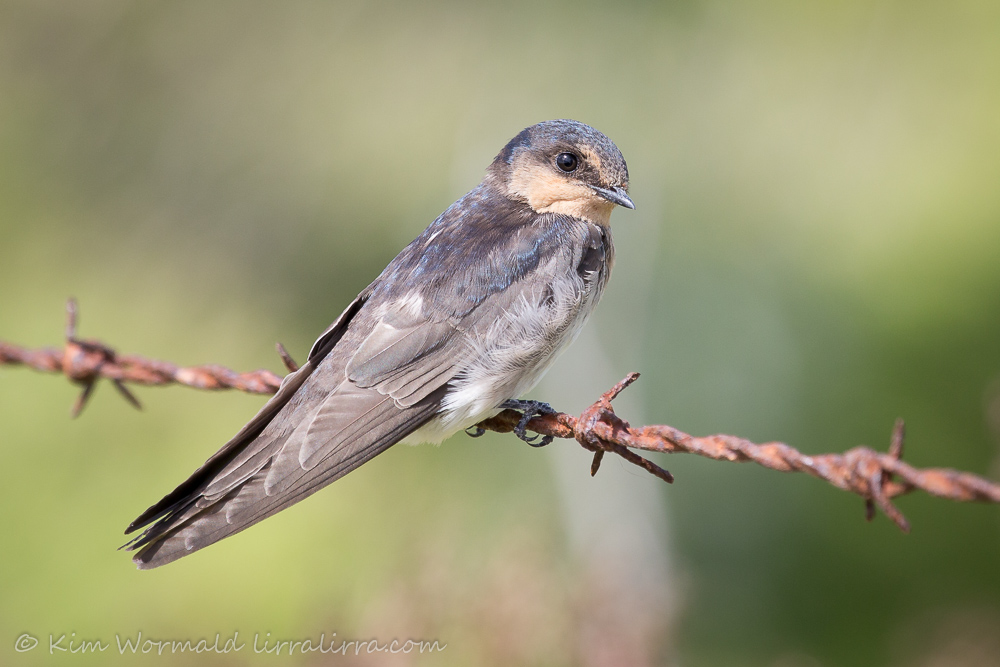 Welcome Swallow
Welcome Swallow
5DIII, 100-400mm L IS USM, 1/800, f6/3, ISO 400, focal length 365mm
The bird above is slightly younger than the other juveniles going by the amount of blue on its back and the lack of any rufous feathers on its buff throat or head.
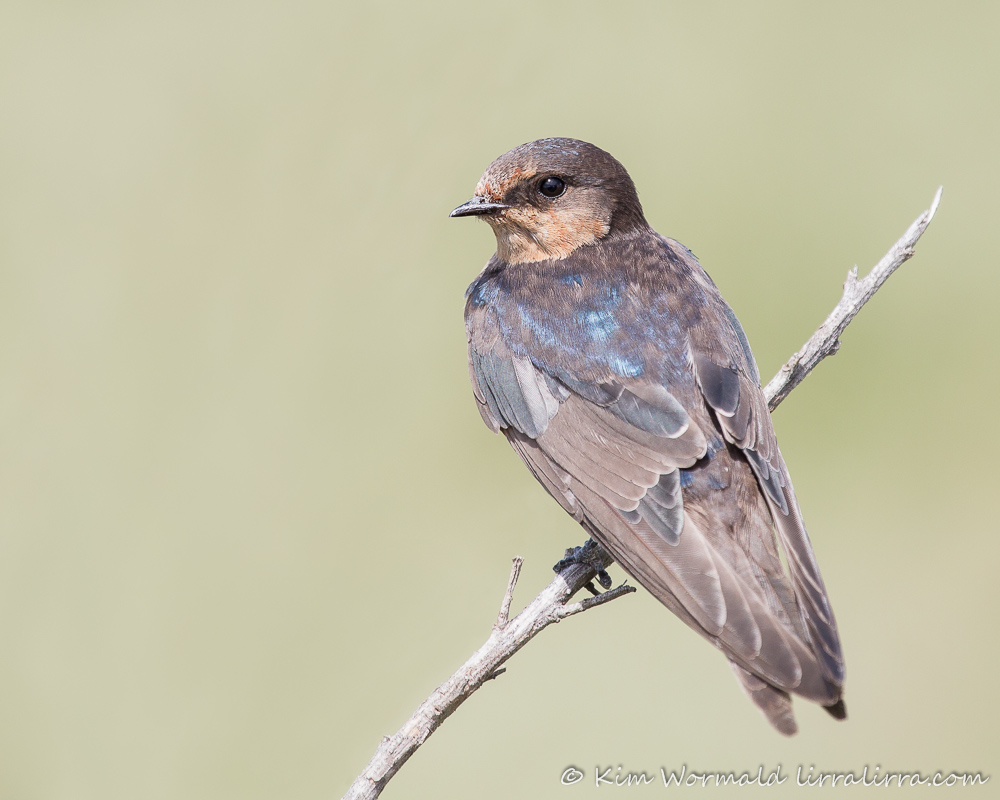 Welcome Swallow
Welcome Swallow
5DIII, 100-400mm L IS USM, 1/800, f/6.3, ISO 400, focal length 400mm
I’m particularly fond of the Welcome Swallow above for looking so stunning and posing nicely on a natural perch!
If anyone knows more about leucism or has stories about birds with unusual colouring please share by adding a comment via the link below.
Happy birding, Kim
PS The Equipment page has been updated to include the 5D Mark III and various other items.
References and further reading:
BTO Looking out for birds
Bird Leucism
NB It is possible to receive a weekly email informing you that lirralirra has been updated – just add your address to the ‘Subscribe to email’ box above right.
Also, I have added a Facebook like button – thank you ‘likers’!

Lovely photos. Can I have permission to paint some of your birds.
I am a botanical artist and include birds in my paontings
Hi Mary, thanks for your question about painting lirralirra birds, I appreciate that you have asked me. Do you post any of your paintings online? I love the idea of these birds being included in botantical artwork. Could you drop me a note at the email address on the Contact page? Thank you.
Hi Kim
Those photographs can be useful in working out if a bird is moulting its primary feathers. The adult on the fence wire is going through a primary moult. You can see it’s older feathers (outside primaries) and the new feathers (primaries closer to the body).
Thank you so much for sharing that! I’d seen the different coloured primaries without registering what I was seeing. It’s interesting to see how worn and faded they become before being replaced. Do you have HANZAB?
just gorgeous, sad to see the colour prejudice in our bird world, but obviously they have there reasons. very informative and stunning work Kim 🙂
It is sad Janele, I totally agree. I’m glad you enjoyed the post and appreciate your comments 🙂
Hi Kim. Great series. I love swallows and it is fun to see different species and their features. Superb detail in your images. Thanks for providing the information on leucism. I enjoy learning about all aspects of bird life.
Hi Julie, I think we’re kindred spirits. I love seeing the details and learning about bird life too. Thank you for commenting.
lovely shots, interesting info
Thanks Julie!
Poor bird, It is sad it is being hassled by its own kind.. They are adorable birds. Great shots. Happy Birding!
It was sad to see it being harassed Eileen, I wondered if dyeing its feathers would give it some rest.
Hi Kim, really nice photos.
Thank you Carole!
Very interesting article Kim, and wonderful photography. Seems there is colour prejudice in the bird world also, but no doubt for different reasons than humans?
Thank you Phillip. I’ve been thinking about the swallows in relation to human colour prejudice too. Maybe the birds recognise the inherent weakness of a bird with abnormally white feathers, which is sad but more understandable if they are trying to ensure the species stays genetically strong. It’s interesting that EC’s galah and some other albinistic/leucistic birds are accepted by their peers.
That poor swallow. I suspect a short and difficult life is in its future.
We once had a white galah visit us for a couple of months. No grey, no pink. The other galahs seem to accept it which surprised me.
I fear you are right EC,it has a lot to cope with. It’s good to hear that your galah was accepted by the others, maybe there is hope for the little swallow.